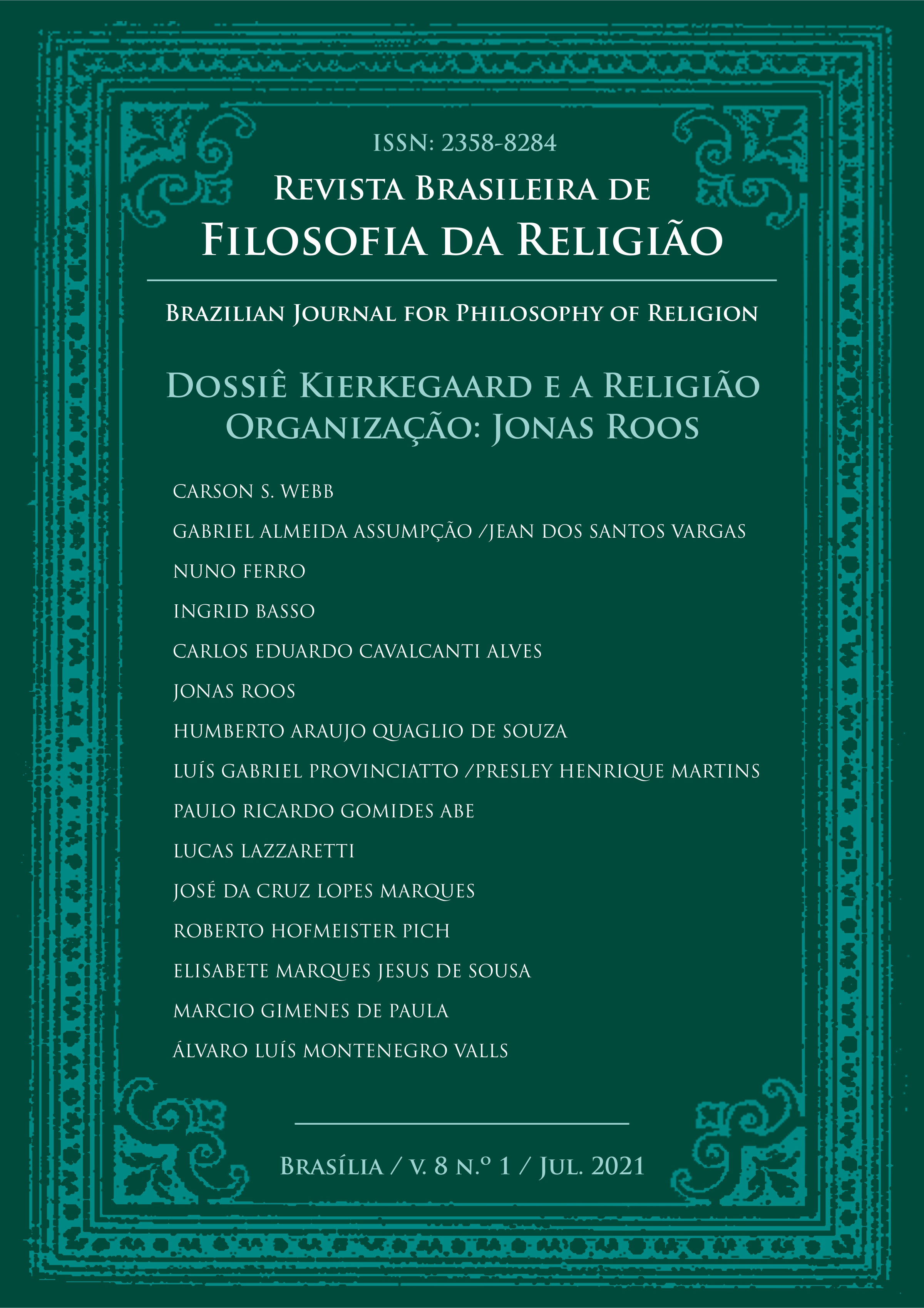THE EXCEPTION AND THE DEMONIC: AROUND “KIERKEGAARD”
DOI:
https://doi.org/10.26512/2358-82842021e38337Keywords:
Comum, Demoníaco, Reclusão, Silêncio, Linguagem, Abraaão, Religioso, ÉticaAbstract
The present article attempts to summarize some of the
aspects in the notion and phenomenon of the "demonic". There is no
intention of thoroughness in the analysis of the problem but of
establishing its place in the framework of philosophical and literary
traditions. The demonic will be observed from the category of
exception, beginning by the examination, from the outset, of its
possibility, then its properties within the ethical, that is, the
difference between good and evil. Special emphasis will be given to
the analysis of the meaning of "common" (det Almene, in the
language of Kierkegaard), that is, the common human denominator.
We will attempt to determine its meaning and avoid the usual
misunderstandings. We will also examine the correspondence to the
so-called life collision phenomena, expulsion from life and their
several possible forms. In the end we will briefly expose what E.A.
Poe calls the "imp of the perverse".
Downloads
References
AGOSTINHO (2014). Confessiones, trad. portuguesa Lisboa: Paulus.
AGOSTINHO (2004). De Vera Religione, trad. portuguesa A Verdadeira Religião. Lisboa: Paulus.
BARBEY D’AUREVILLY, Jules (1999). Les Diaboliques. Paris: Le Livre de Poche.
BARBEY D’AUREVILLY, Jules (1884). Le Constitutionnel, Mardi: 29 Juillet.
BAUDELAIRE, Charles (1961), Le Spleen de Paris, in Oeuvres Complètes, Paris, Gallimard.
BERNANOS, Georges (2019). Monsieur Ouine, L’Arbre Vengeur (s/ indicação de cidade).
BUBER, Martin (2016). Eclipse of God. Princeton: Princeton University Press.
CERRIGONE, Mario (2002). Il Demoniaco in Kierkegaard. Divus Thomas. 105: 59-87.
CLAIR, André (1979). Le Mythe de Faust et le concept kierkegaardien de démoniaque.
Revue Philosophique de Louvain. 77: 24-50.
CONRAD, Joseph (1992). Lord Jim. New York. London: Everyman’s Library.
CONRAD, Joseph (2004). Lord Jim. Lisboa: Europa-América.
DE KEYZER, Stéphane (2006). Kierkegaard et l’Exception: Quelle communauté entre le
crime et l’innocence? Revue Philosophique de Louvain. 104: 467-497.
DROLET, Bernard (1971). Le Démoniaque chez S. S. Kierkegaard. Quebec: Joliette.
FENVES, Peter (2014). "Kierkegaard and the Definition of the Demonic" by GEULEN,
E. et. al. Das Dämonische. The Hague. Brill: 193-200.
FERNIE, Ewan (2013). The Demonic. Literature and Experience. London and New York: Routledge.
GIDE, André (1951). Journal 1889-1939. Paris: Gallimard.
HALL, Ronald (1985). "Language and Freedom: Kierkegaard’s Analysis of the Demonic
in The Concept of Anxiety" by PERKINS, R. (ed.). The Concept of Anxiety: International
Kierkegaard Commentary, vol. 8. Macon (Georgia): Mercer University Press: 153-166.
HAQUE, Ziaul (2015). ’One of Us’ in Joseph Conrad’s Lord Jim: Fact or Myth?. Journal of English Language and Literature. (3): 312-318.
HARDING, Carol (ed.) (2010). Moral Dilemmas and Ethical Reasoning. New Brunswick: Transaction Publishers.
HAWTHORNE, Nathaniel (1973). Hawthorne’s Short Stories. New York: Vintage Books.
HEGEL, Georg W. F. (1986). Grundlinien der Philosophie des Rechts in Werke, vol. 7.
Frankfurt: Suhrkamp.
HEINE, Heinrich (1827). Buch der Lieder. Hamburg: Hoffmann und Campe.
KANT, Immanuel (1900). Der Streit der Fakultäten in Kants Gesammelte Schriften, vol, 7. Berlin: G. Reimer.
KIERKEGAARD, Søren (2006). Sygdommen til Døden in Søren Kierkegaards Skrifter,
vol. 11. København: Gads Forlag.
KIERKEGAARD, Søren (2003). Journalen, in Søren Kierkegaards Skrifter, vol. 27. København: Gads Forlag.
KIERKEGAARD, Søren (2001a). Journalen in Søren Kierkegaards Skrifter, vol. 18. København: Gads Forlag
KIERKEGAARD, Søren (2001b). Journalen, in Søren Kierkegaards Skrifter, vol. 21. København: Gads Forlag.
KIERKEGAARD, Søren (1997a). Begrebet Angst in Søren Kierkegaards Skrifter, vol. 4. København: Gads Forlag.
KIERKEGAARD, Søren (1997b). Frygt og Bæven in Søren Kierkegaards Skrifter, vol. 4. København: Gads Forlag.
KIERKEGAARD, Søren (1997c). Gjentagelsen in Søren Kierkegaards Skrifter, vol. 4.
København: Gads Forlag.
KIERKEGAARD, Søren (1997d). Enten-Eller in Søren Kierkegaards Skrifter vol. 3. København: Gads Forlag.
KIERKEGAARD, Søren (1996). Stadiets paa Livets Vei in Søren Kierkegaards Skrifter, vol. 6. København: Gads Forlag.
KIERKEGAARD, Søren (1968). Søren Kierkegaards Papirer by P. A. Heiberg, V. Kuhr, E. Torsting e Niels Thulstrup. København: Gyldendal.
LA FONTAINE, (1982). Contes et Nouvelles en Vers. Paris: Gallimard.
LA ROCHEFOUCAULD (1967). Maximes (ed. Truchet). Paris: Garnier.
LANGSTON, Douglas (2001). Conscience and Other Virtues: from Bonaventura to
MacIntyre. University Park (Penn.): The Pennsylvania State University Press.
MALANTSCHUK, Gregor (1968). Dialektik og Eksistens hos S. Kierkegaard. København: Reitzel.
McDONALD, William (2014). Demonic, Kierkegaard’s Concepts, vol. 15, t. 2. London and New York: Routledge: 147-152.
MININGER, Jay Daniel (2007). Allegories of the Demonic. Kierkegaard Studies Yearbook. Berlin: de Gruyter: 514-529.
MØLLER, Poul Martin (1965). Filosofiske Essays og Strøtanker. København: Gyldendal.
MONTAIGNE, Michel (2017). Essais (ed. Villey-Saulnier). Paris: PUF.
NAGEL, Thomas (1991). "The Fragmentation of Value" in Mortal Questions.
Cambridge: Cambridge University Press: 128-141.
NICA, Daniel (2017). Modern Perspectives on Faith: Abraham’s Case in Kant and
Kierkegaard. Reconstructions and Critical remarks. Annals of the University of Bucharest. 46: 107-123.
NIETZSCHE, Friedrich (1988) Jenseits von Gut und Böse, IV, 153 in COLLI, G.,
MONTINARI, M., F. Nietzsche. Werke, vol. 5. de Gruyter: Berlin-New York.
PASCAL, Blaise (2000). Pensées (ed. Sellier). Paris: Le Livre de Poche.
PESSOA, Fernando (2020). Livro do Desassossego (ed. J. Pizarro). Lisboa: Tinta da China.
PODMORE, Simon (2013). Struggling with God: Kierkegaard and the Temptation of Spiritual Trial. London: James Clarke and Co.
Downloads
Published
How to Cite
Issue
Section
License
Copyright (c) 2022 Brazilian Journal for Philosophy of Religion

This work is licensed under a Creative Commons Attribution 4.0 International License.

